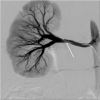Renovascular hypertension in children
- PMID: 33411105
- PMCID: PMC7790992
- DOI: 10.1186/s42155-020-00176-5
Renovascular hypertension in children
Abstract
Paediatric hypertension, defined as systolic blood pressure > 95th percentile for age, sex and height is often incidentally diagnosed. Renovascular hypertension (RVH) is responsible for 5-25% of hypertension in children. Renal artery stenosis and middle aortic syndrome can both can be associated with various conditions such as fibromuscular dysplasia, Williams syndrome & Neurofibromatosis type 1. This paper discusses the approaches to diagnosis and interventional management and outcomes of renovascular hypertension in children. Angiography is considered the gold standard in establishing the diagnosis of renovascular disease in children. Angioplasty is beneficial in the majority of patients and generally repeated angioplasty is considered more appropriate than stenting. Surgical options should first be considered before placing a stent unless there is an emergent requirement. Given the established safety and success of endovascular intervention, at most institutions it remains the preferred treatment option.
Keywords: Fibro-muscular dysplasia; Mid-aortic syndrome; Paediatric interventional radiology; Renal artery stenosis.
Conflict of interest statement
Not applicable.
Figures







References
-
- Alhadad A, Ahle M, Ivancev K, Gottsäter A, Lindblad B. Percutaneous transluminal renal angioplasty (PTRA) and surgical revascularisation in renovascular disease--a retrospective comparison of results, complications, and mortality. Eur J Vasc Endovasc Surg Off J Eur Soc Vasc Surg. 2004;27:151–156. doi: 10.1016/j.ejvs.2003.10.009. - DOI - PubMed
Publication types
LinkOut - more resources
Full Text Sources
Other Literature Sources
Research Materials
